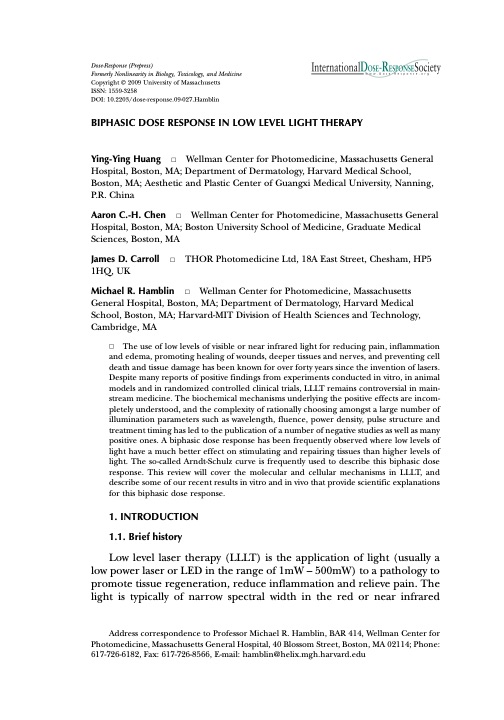
PDF Publication Title:
Text from PDF Page: 001
Dose-Response (Prepress) Formerly Nonlinearity in Biology, Toxicology, and Medicine Copyright © 2009 University of Massachusetts ISSN: 1559-3258 DOI: 10.2203/dose-response.09-027.Hamblin BIPHASIC DOSE RESPONSE IN LOW LEVEL LIGHT THERAPY Ying-Ying Huang Wellman Center for Photomedicine, Massachusetts General Hospital, Boston, MA; Department of Dermatology, Harvard Medical School, Boston, MA; Aesthetic and Plastic Center of Guangxi Medical University, Nanning, P.R. China Aaron C.-H. Chen Wellman Center for Photomedicine, Massachusetts General Hospital, Boston, MA; Boston University School of Medicine, Graduate Medical Sciences, Boston, MA James D. Carroll THOR Photomedicine Ltd, 18A East Street, Chesham, HP5 1HQ, UK Michael R. Hamblin Wellman Center for Photomedicine, Massachusetts General Hospital, Boston, MA; Department of Dermatology, Harvard Medical School, Boston, MA; Harvard-MIT Division of Health Sciences and Technology, Cambridge, MA The use of low levels of visible or near infrared light for reducing pain, inflammation and edema, promoting healing of wounds, deeper tissues and nerves, and preventing cell death and tissue damage has been known for over forty years since the invention of lasers. Despite many reports of positive findings from experiments conducted in vitro, in animal models and in randomized controlled clinical trials, LLLT remains controversial in main- stream medicine. The biochemical mechanisms underlying the positive effects are incom- pletely understood, and the complexity of rationally choosing amongst a large number of illumination parameters such as wavelength, fluence, power density, pulse structure and treatment timing has led to the publication of a number of negative studies as well as many positive ones. A biphasic dose response has been frequently observed where low levels of light have a much better effect on stimulating and repairing tissues than higher levels of light. The so-called Arndt-Schulz curve is frequently used to describe this biphasic dose response. This review will cover the molecular and cellular mechanisms in LLLT, and describe some of our recent results in vitro and in vivo that provide scientific explanations for this biphasic dose response. 1. INTRODUCTION 1.1. Brief history Low level laser therapy (LLLT) is the application of light (usually a low power laser or LED in the range of 1mW – 500mW) to a pathology to promote tissue regeneration, reduce inflammation and relieve pain. The light is typically of narrow spectral width in the red or near infrared Address correspondence to Professor Michael R. Hamblin, BAR 414, Wellman Center for Photomedicine, Massachusetts General Hospital, 40 Blossom Street, Boston, MA 02114; Phone: 617-726-6182, Fax: 617-726-8566, E-mail: hamblin@helix.mgh.harvard.eduPDF Image | BIPHASIC DOSE RESPONSE IN LOW LEVEL LIGHT THERAPY

PDF Search Title:
BIPHASIC DOSE RESPONSE IN LOW LEVEL LIGHT THERAPYOriginal File Name Searched:
Biphasic-Dose-Response-in-Low-Level-Light-Therapy-Harvard.pdfDIY PDF Search: Google It | Yahoo | Bing
Cruise Ship Reviews | Luxury Resort | Jet | Yacht | and Travel Tech More Info
Cruising Review Topics and Articles More Info
Software based on Filemaker for the travel industry More Info
The Burgenstock Resort: Reviews on CruisingReview website... More Info
Resort Reviews: World Class resorts... More Info
The Riffelalp Resort: Reviews on CruisingReview website... More Info
| CONTACT TEL: 608-238-6001 Email: greg@cruisingreview.com | RSS | AMP |